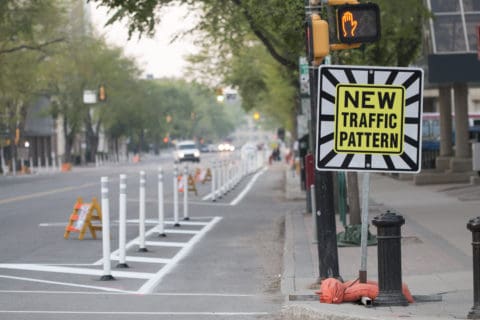As the City of Saskatoon launches phase two of its Protected Bike Lane Demonstration Project with new designated bike lanes along a section of Fourth Avenue, some members of the University of Saskatchewan community are skeptical.
The bike lanes will run along Fourth Avenue from the Broadway Bridge to 24th Street. According to Alan Wallace, the city’s head of planning and development, the initiative forms part of a larger active transportation plan that he hopes will encourage residents to be more active and ultimately increase overall sustainability.
However, Avi Akkerman, a U of S professor of geography and urban planning, says the city’s current direction is anything but sustainable.

New bike lanes in Saskatoon, running along Fourth Avenue from 24th Street to the Broadway Bridge, have mixed reviews.
“The fact of the matter is that [the city] talks about halting urban sprawl, but it actually promotes it. As a result, be it transit or bikes, the city cannot feasibly sustain alternative modes of transportation,” Akkerman said in an email to the Sheaf.
Anthony Wood is a third-year regional and urban planning major and sits on the Planning Students Association. Like many students at the U of S, Wood uses cycling as a frequent mode of transportation. He sees the value of the new bike lanes as measures of safety and sustainability — two points Wallace cites as objectives of the project.
Still, in Wood’s opinion, the plan falls short.
“I was a bit concerned when I saw the network gets to like the Broadway Bridge, and then it just kind of ends. I’m just wondering what that’s actually going to kind of look like and feel like,” Wood said.
He suggested that from a cyclist’s perspective, the networks should connect with one another.
“The last thing I want is people to be thrust onto the Broadway Bridge after having a nice pleasurable experience, and it’s like oh man. It’s like, down to business right now. We’re on the bridge. People are driving around.”
While Akkerman agrees that bike lanes are one critical aspect of sustainable urban living, he maintains that numerous shifts in priority and policy will be required if the city hopes to effect any real change.
“[The city] should stop building overpasses and expanding maintenance intensive freeways, and instead divert [money] onto pedestrian and bicycle infrastructure that could support active transportation all-year round, in the winter in particular,” Akkerman said.
Akkerman provided a list of strategies to the Sheaf that he says will improve the level of sustainability in Saskatoon. It includes measures such as taxes and levies on automobile usage and building outside of established geographic limits, audits and assessments of existing policies and publication of their results, including the environmental damage. He also suggests improving sidewalks and alleyways for pedestrian use.
Wallace echos some of Akkerman’s strategies, such as building within specific boundaries as well as modifying structures to make Saskatoon’s downtown core more pedestrian and cyclist friendly.
“We have a city centre plan that’s been adopted, and we’re adopting strategies to increase the amount of structured parking downtown so that we grow up as opposed to using our surface vacant lots for parking,” Wallace said.
According to Wallace, the city is making an effort to increase urban population density overall.
“There used to be around five dwellings per acre, now we have about seven-to-eight dwellings per acre. They are getting denser,” Wallace said.
Improvements aside, Wood points to the steady expansion of suburbs such as University Heights and Kensington.
“We’re not stopping. That’s the thing. Saskatoon isn’t stopping the sprawl,” Wood said. “Talk about sustainability all you want, but we’re still building out and you know it’s just not ending.”
The parties agree that the new bike lanes are a step in the right direction and that more work needs to be done before the city can claim real sustainability. For the time being, students who bike to campus from certain parts of the downtown core can anticipate an easier morning commute.
—
Patty Hails
Photo: Caitlin Taylor